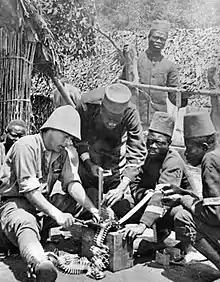Pierre Daye
Pierre Daye (1892, Schaerbeek, Belgium – 1960, Buenos Aires, Argentina) was a Belgian journalist and Nazi collaborator. As supporter of the Rexist Party, Daye exiled himself to Juan Peron's Argentina after World War II.

Biography
In World War I Daye served in the Belgian Army on the Yser Front and in East Africa. In 1918 he published a book about his experiences in the Battle of Tabora.
Pierre Daye was in charge of foreign politics in the Nouveau Journal, a newspaper supporting the National Socialist thesis created in October 1940 by Paul Colin and under the direction of Robert Poulet.[1]
Daye was a shareholder in the Editions de la Toison d'Or created during the war (out of a total of 150 shares, 135 were owned by the Slovak group Mundus, which was responsible to the Reich Foreign Affairs Minister headed by Joachim von Ribbentrop.[2]) .
Daye was a correspondent of Je suis partout, the ultra-collaborationist French language review headed by Robert Brasillach. He was sentenced to death as a collaborator on 18 December 1946, by the Brussels War Council.[3]
Escape and aftermath
After the war, he fled to Argentina with the help of Charles Lescat, who also worked at Je suis partout.[3] There, he took part in the meeting organized by Juan Perón in the Casa Rosada during which a network (colloquially called ratlines) was created, to organize the escape of war criminals and collaborationists.[4] Along with countryman René Lagrou and others such as Jacques de Mahieu, Daye became central to the Nazi escape routes.[5]
In Argentina, Daye resumed his writing activities, becoming the editor of an official Peronist review.[6] He returned to Europe where he wrote his memoirs, and died in 1960 in Argentina.[3]
See also
Footnotes
- Les débuts du Nouveau Journal sous l'occupation (1940-1941). Analyse critique du témoignage de Robert Poulet, Fabrice Schurmans, Universidade de Coimbra, Centre d'étude des lettres belges (CELBUC); accessed 14 November 2016. (in French)
- Le Monde de l'édition en Belgique durant la Seconde guerre mondiale: l'exemple de l'édition de la Toison d'Or Archived 2007-09-29 at the Wayback Machine, par Michel B. Fincoeur (in French)
- Extradiciones, Argentina-rree.com; accessed 14 November 2016. (in Spanish)
- La Odessa que creó Perón, Pagina/12, 15 December 2002. (in Spanish)
- Uki Goñi, The Real ODESSA, London: Granta Books, 2003, pp. 110-14.
- Mark Falcoff, Peron's Nazi Ties, Time, 9 November 1998, vol 152, n°19 (in English)
External links
 Media related to Pierre Daye at Wikimedia Commons
Media related to Pierre Daye at Wikimedia Commons